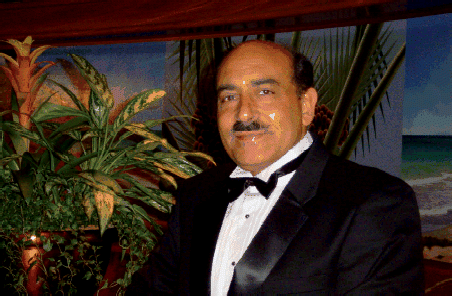
This special issue of Philosophical Magazine, ‘Collective Behavior of Complex Dislocation Structures,’ is dedicated to Professor Nasr M. Ghoniem of the University of California, Los Angeles (UCLA). The issue includes a subset of papers presented at the symposium on ‘Defects in Materials’ that was organized by Professor Ghoniem's friends and colleagues to honor him on the occasion of his 60th birthday, at the Fourth International Conference on Multiscale Modeling of Materials (Florida State University, October 27–31, 2008).
Nasr M. Ghoniem was born March 5, 1948 in the Mediterranean city Alexandria (Egypt). He finished his undergraduate studies in Nuclear Engineering at the University of Alexandria, and then obtained an M. Eng. degree in Engineering Physics (Solid State) from McMaster University, and MS and Ph.D. degrees in Nuclear Engineering (Materials) from the University of Wisconsin at Madison in 1977, and joined UCLA as an assistant professor in the same year, where he became a full professor in 1986, and was promoted to the rank of distinguished professor in 2006.
His research interests are in the areas of damage and failure of materials in mechanical and nuclear design, mechanics and physics of material defects, plasma and laser processing of materials, material degradation in severe environments, and interactions of ions, neutrons, electrons and photons with materials. In several of these areas, he also focuses on self-organization of defects and pattern formation in materials under non-equilibrium conditions.
Prof. Ghoniem was elected fellow of the American Nuclear Society in 1994, which was followed by Outstanding Achievement Awards, from the Fusion Energy Division of ANS in 1998 and from the Materials Science Division of ANS in 2006. As a result of his research on the plasticity and failure of materials in irradiated and high-temperature environments, he was elected fellow of the American Society of Mechanical Engineers (ASME) in 2006, and in 2009 he was elected fellow of the American Academy of Mechanics (AAM).
His publication record includes over 350 articles, with over 240 refereed journal articles on structural materials for fission and fusion energy, microscale plasticity (dislocation dynamics), defects in SiC, and helium transport and clustering in irradiated materials. He edited eight books on applied plasma science, multiscale modeling of materials, plasticity and fracture, and nano- and micro-mechanics. He recently co-authored a two-volume book published by Oxford Press (2008): Nasr M. Ghoniem and Daniel Walgraef, Instabilities and Self-Organization in Materials, which define most of the current research on material instabilities and self-organization including irradiated materials.
During his Ph.D. research at UW, he developed theoretical models for the dynamics of point defects and void swelling of structural materials under pulsed irradiation. His theoretical research on the effects of radiation pulsing on materials has defined many of the characteristics of microstructure evolution and several material properties, and his findings were confirmed later by experiments. During the first fifteen years of his career, his contributions included the development of the Fokker-Planck stochastic theory of atomic clustering and its applications to microstructure evolution in thin films and irradiated materials, the rate theory of helium transport and clustering in irradiated materials, with numerous applications to grain boundary fracture and swelling of irradiated materials, and thermal and irradiation creep of materials. He developed some of the earliest works on Monte Carlo (MC) and Molecular Dynamics (MD) simulations of displacement cascades and defect production in irradiated materials, ion implantation and coupled electron-ion transport in semiconductors, and the stability of materials under extreme conditions. In 1988, he pioneered the development of a ground-breaking computational method, known now as “Dislocation Dynamics,” for the simulation of the collective dynamics of three-dimensional line defects (dislocations) that carry plastic flow in materials. His research has led to world-wide and continuing efforts to establish a physical theory of plasticity of materials, with significant implications in the design of advanced materials with superior mechanical properties. Prof. Ghoniem was among the first to recognize the importance of environmentally-friendly structural materials, where he ventured into the experimental development of low-activation steels. He holds the first world patent on the development of low activation ferritic/martensitic steels (US Patent No. 4,622,067, November 11, 1986 (with D.S. Gelles and R.W. Powell). These alloys currently represent one of the main structural material systems for fission and fusion energy applications.
His long career at UCLA as an educator resulted in over 30 completed Ph.D.s (seven professors, while the others hold leading positions at National Laboratories and in industry), 40 M.S. degrees, and the supervision of over 25 post doctoral and professional staff members from many areas of the world. Six of his former post-doctoral students hold professorial positions as well.
The colleagues and friends of Prof. Ghoniem are pleased to dedicate this special issue to him in recognition of his contributions to the wide field of theoretical and computational materials science and mechanics.